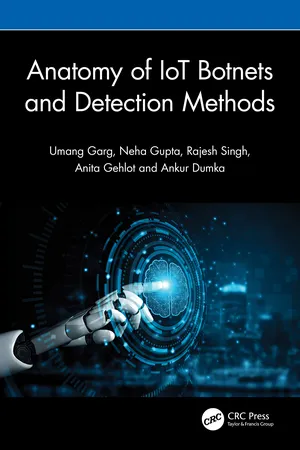
Anatomy of IoT Botnets and Detection Methods
- English
- ePUB (mobile friendly)
- Available on iOS & Android
Anatomy of IoT Botnets and Detection Methods
About this book
The book Anatomy of IoT Botnets and Detection Methods delves into the evolving landscape of cybersecurity threats associated with the Internet of Things (IoT), specifically focusing on the anatomy, behavior, and detection of IoT-based botnets. As IoT devices proliferate in both consumer and industrial settings, their inherent vulnerabilities—such as weak authentication, limited processing power, and lack of regular updates—make them prime targets for attackers. The book begins by exploring how IoT botnets are formed, highlighting key attack vectors such as malware propagation, command, and control (C&C) mechanisms, and commonly exploited protocols such as Telnet and UPnP. Notable case studies, including the Mirai and Mozi botnets, illustrate real-world impacts, emphasizing the scale and damage these threats can inflict. The core of the book then transitions into detection methodologies, covering both traditional and AI-driven approaches. Techniques such as signature-based detection, anomaly detection using machine learning, network traffic analysis, and honeypot deployment are thoroughly examined. The authors also address the challenges in detecting IoT botnets, including encrypted traffic, device heterogeneity, and low visibility in resource-constrained devices. Furthermore, the book emphasizes the importance of proactive defense strategies, such as firmware hardening, secure boot mechanisms, and real-time behavioral analytics. It underscores the role of collaborative intelligence sharing among stakeholders to enhance detection capabilities. By integrating theoretical concepts with practical insights and current research trends, the book provides a comprehensive guide for researchers, cybersecurity professionals, and IoT developers aiming to understand and counteract botnet threats. Ultimately, Anatomy of IoT Botnet and Detection Methods serves as a crucial resource for strengthening the cybersecurity posture of IoT ecosystems through informed detection and mitigation practices. The content of the book is categorized into the following sub-sections:
- Introduction to IoT and Botnets: An overview of IoT technology, its adoption, and the rising threat of botnets.
- IoT Device Vulnerabilities: Analysis of common security weaknesses in IoT devices that cybercriminals exploit.
- Botnet Architecture: Detailed examination of how IoT botnets are structured, including command-and-control mechanisms.
- Infection and Propagation: Methods used by attackers to spread malware across IoT networks.
- Detection Techniques: Overview of current detection methods, including anomaly detection, signature-based approaches, and machine learning.
- Mitigation Strategies: Practical advice on how to secure IoT devices, including best practices for manufacturers and users.
- Case Studies: Real-world examples of IoT botnet attacks and their impact.
The book concludes with a discussion on the future of IoT security, emphasizing the need for continuous innovation in detection and prevention methods.
Frequently asked questions
- Essential is ideal for learners and professionals who enjoy exploring a wide range of subjects. Access the Essential Library with 800,000+ trusted titles and best-sellers across business, personal growth, and the humanities. Includes unlimited reading time and Standard Read Aloud voice.
- Complete: Perfect for advanced learners and researchers needing full, unrestricted access. Unlock 1.4M+ books across hundreds of subjects, including academic and specialized titles. The Complete Plan also includes advanced features like Premium Read Aloud and Research Assistant.
Please note we cannot support devices running on iOS 13 and Android 7 or earlier. Learn more about using the app.
Information
Table of contents
- Cover Page
- Half Title page
- Title Page
- Copyright Page
- Dedication
- Contents
- Foreword
- Preface
- Acknowledgments
- Author biographies
- Abbreviations
- Chapter 1 Introduction
- Chapter 2 IoT device vulnerabilities
- Chapter 3 Understanding IoT botnets
- Chapter 4 Real-world IoT botnet case studies
- Chapter 5 Detection techniques for IoT botnets
- Chapter 6 Mitigation and prevention strategies
- Chapter 7 The role of IoT manufacturers and developers
- Chapter 8 Global perspectives on IoT security
- Chapter 9 Future trends in IoT botnets and security
- Summary
- Bibliography
- Index